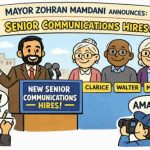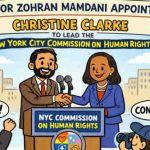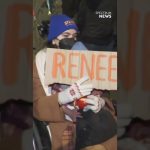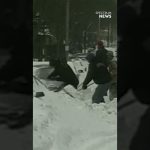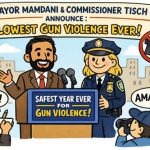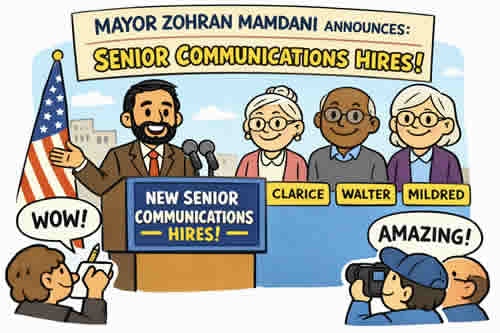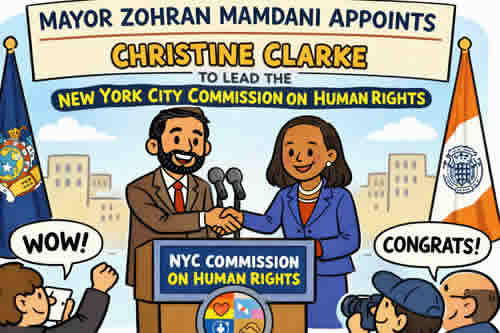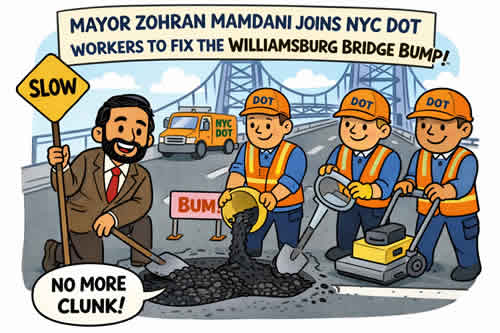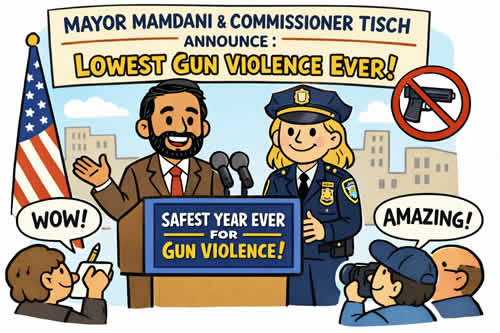we don’t get this done without our volunteers, and I just want to say thank you so much for the volunteers who come out. I remember the years being at Prospect Park. The volunteers would come out, do the grooming, the trees, the cleaning, they are really dedicated to the park. And the announcement that we are making today around using our trees to cool up our planet, of the miles of trails where you’re able to walk through and really enjoy, it is an extension of how we really deescalate the stress that we feel so much in the iron, the brick and fast moving city that we live in. And so the excitement of today is a continuation of what we are doing around Earth Week.
It’s everything from the solar panels, how do we look at food to improve our environment, how do we ensure Local Law 97 is moving us forward to ensure that fossil fuels in our buildings, in our cars are battery usage and EVs, electric vehicles. Looking at things that are doable, executable and accountable to the people of this city. And so this excitement today, we have a series of events that are taking place all over the entire city. I say over and over again, we have two mothers. One gave birth to us, the other sustained us. The same love and nurturing that we show the mom that gave birth to us, let’s show it to the one that sustains us.
Mother Earth is here, is going to continue to be a part of who we are and we have to ensure that we give it the treatment that she deserves. So I’m excited about today. I look forward to the paths, these beautiful paths that we have here in the park trails. Come out. Walk, come out, enjoy Earth Day and come out and be a volunteer. So again, thank you volunteers. Thank you Sue for doing your thing. Thank you.
Commissioner Donoghue: Thank you. Thank you so much, Mr. Mayor. As the, get stuff done Mayor, it’s no surprise that you’re out here, you’re rolling up your sleeves with us and you’re getting to work with us today. As he said, to take care of our trails, to take care of Mother Nature. Today on Earth Day, we’re all gathered here with one goal in mind, working together as a team to make our parks and green spaces the best that they can be. Tucked within our dense urban environment, our parks offer respite, relaxation, and recreation for countless New Yorkers. With over 30,000 acres of parkland across the city, including 12,000 acres of natural areas, our urban park system here in New York City is one of the greatest in the world.
Standing here in Alley Pond Park, it’s easy to see the benefits of our trees and natural areas. They provide cool for our neighborhoods. They clean our air and offer unparalleled opportunities to get away from the hustle and bustle of everyday life in the city. And thanks to this mayor, thanks to Mayor Adams and his commitment to green spaces, they’re about to get even better. As part of the recently released PlaNYC, Mayor Adams has furthered his commitment to what I’m calling the four Ts in parks, trees, trails, training, and importantly teamwork. Through efforts to expand tree canopy cover, we will continue to plant trees across the city with a particular focus on heat vulnerable areas, and care for our existing trees so that they could continue to offer benefits to New Yorkers for decades to come.
By focusing as we are here today on our network of 300 miles of natural area trails, we will better connect New Yorkers to that very nature that the mayor talked about that surrounds them, which is so important we know for both physical and mental health. By adding new and clearly branded trail markers, trail improvements where needed and new maps on our website, our trails will be more accessible to more New Yorkers than ever before. Also, with new training programs for our climbers and pruners, we will look to simultaneously add good green jobs to our city and maximize our tree preservation efforts to make sure we are fully equipped to meet the demands of a growing urban forest.
And with teamwork, with the folks like you see behind me, through our stewardship program and our dedicated partner organizations, we will look to better support our existing network of dedicated volunteers and usher in a new generation of ecologically minded stewards. I say this to all of you gathered here today, our dedicated New Yorkers who have come out to support our efforts every Earth Day, thank you so much. We need your help, and it is so appreciated. Your volunteerism and support for our parks is instrumental to our efforts to care for, preserve and expand our city’s vital park spaces. I’m looking forward to getting my hands dirty with you all today.
Before today, both planting trees and into the future as we work towards our common goal. Before I call up our next speaker, I would really like to acknowledge and thank a few people who are with us today, including… We’ve got Emily Nobel Maxwell, New York City’s program director for the Nature Conservancy. I want to give a big shout-out to the Parks Department Environment and Planning Group who put together this day and do so much. Our park stewardship organization. And last but not least, all of you, our volunteers and especially the AKAs, the sorority that’s right behind me. Now, it gives me great pleasure to invite a major advocate for our environment, for equity and fairness in our city, Kizzy Charles Guzman.
Kizzy Charles-Guzman, Executive Director, Mayor’s Office of Climate and Environmental Justice: Good morning everybody. Thank you for coming. I’m so happy to be here with you today doing the three things I love, volunteering, hanging out with Sue and the Mayor and enjoying New York’s open space. So two days ago, Mayor Adams and my team released PlaNYC. It focuses not only on how we’re going to live with climate change, but also how we live our day-to-day in our beloved city. The plan is about New Yorkers’ relationship with our lived environment, our homes, our schools, our streets, and also our parks and open spaces like Alley Pond Park. So I want to tell you a story about a New Yorker whose relationship to his lived environment changed due to a sudden crisis.
He was catapulted into a strange new world, but like most New Yorkers, he learned new skills and figured out how to adapt to a place very different from the one he knew. This New Yorker lives on the Upper West Side. Until recently, he spent most of his time in a small apartment and he ordered in all the time, and that was until he escaped the Central Park Zoo. That’s right, I’m talking about Flaco, the Eurasian eagle-owl. In early February, someone cut the mesh of its enclosure, and since then Flaco has been free in Central Park. At first, he was small and stressed and wobbly, but almost three months later, he learned to fly. He is stronger. He spends most of his time near a narrow waterway in the park’s northern region.
He has grown so large and has learned to hunt. He has been called a true New Yorker, adaptable, resilient, and a role model. And I know that it is music to the ears of this man over here, that Flaco has been hunting many rats. Ordinary New Yorkers, not just birders, are trekking to the park to get a glimpse of him. There are binoculars and tripods and groups, there are Instagram videos, New York Times stories, there are murals, there are Twitter accounts, and that’s because New Yorkers have always cared about nature. Sustainability is more than buildings and cars, and resiliency’s far more than hurricanes and flooding.
PlaNYC aims to restore New Yorkers’ relationship with nature and our biodiversity, and to show how investing in our open spaces will improve equity, social resiliency, and our health. With your help, our open spaces can be part of the solution that can keep us cool outdoors and safe indoors in the summer and can keep us healthy and resilient as the planet warms. Besides the initiatives that Sue and the mayor have mentioned, this plant will also restore and steward a thousand acres of forests at 10 different sites, plant more than 30,000 native trees and shrubs, make sure people can safely cool down in pools and beaches by investing in swim safety programs, coat a million square feet of rooftops per year and help us develop new street projects that can mitigate heat risk.
In ending, Deborah Jaffe, a lifelong New Yorker said that, “Owls have always been the hardest birds to see, which makes them the most thrilling types of birds to see.” I’m touched by Flaco’s story because adapting to climate change is hard, but it opens new and thrilling relationships to our environment. We are your partners as we adjust to living in a changing but remarkable world. To our volunteers, thank you. We can’t do this without you.
More at NYC.gov
